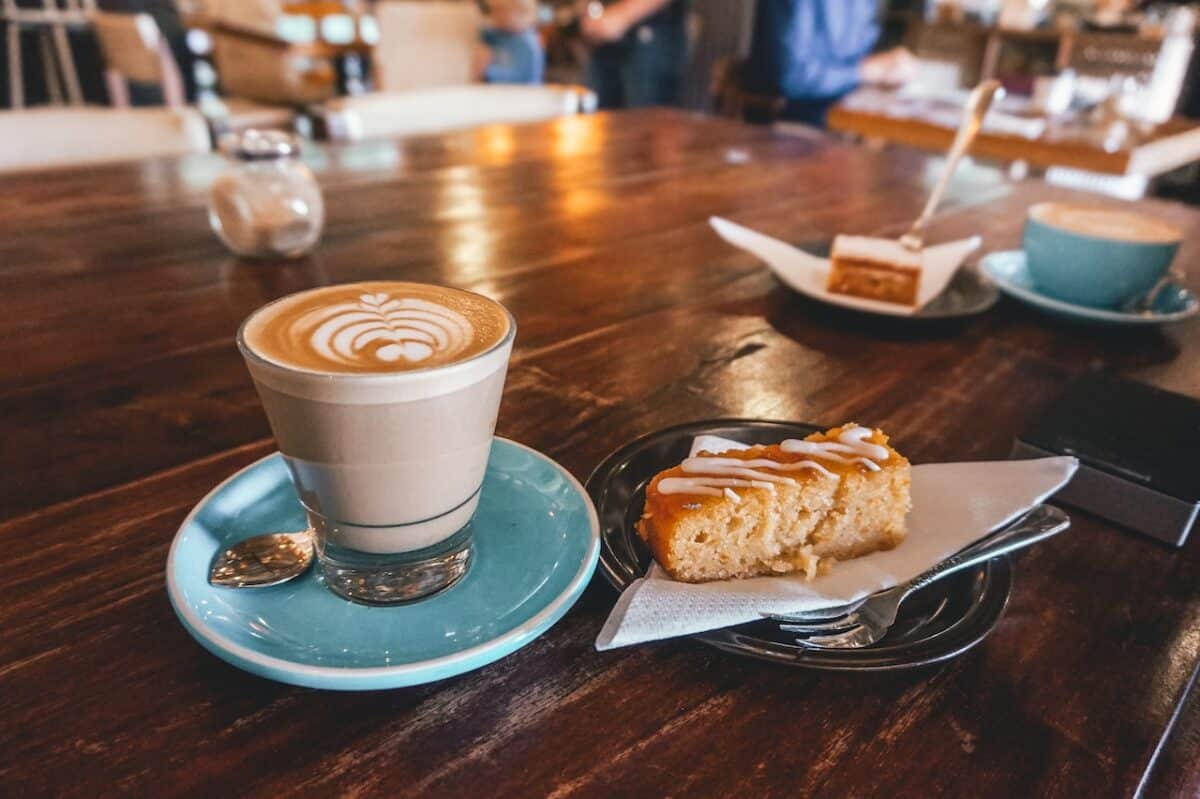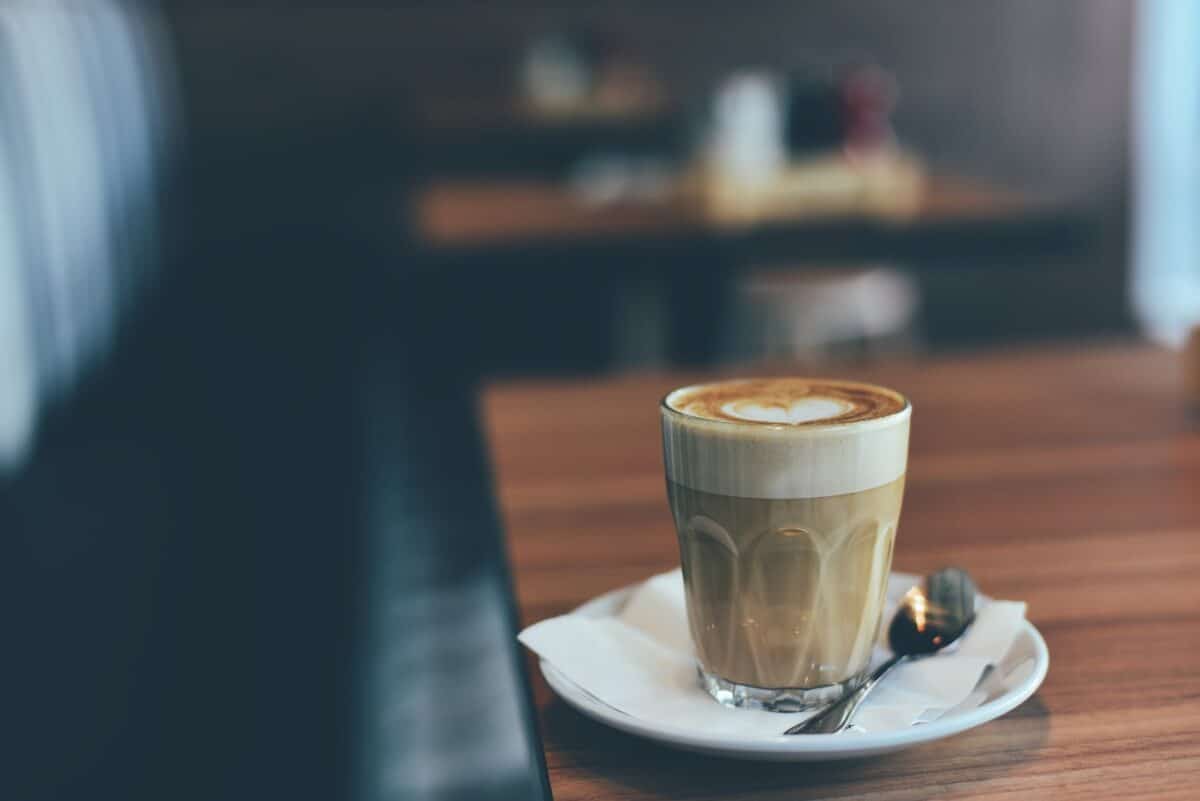As a coffee enthusiast, I’ve noticed that lattes are often served in glasses rather than traditional mugs or cups. In my quest to understand this unique presentation, I discovered a few compelling reasons why a latte is served in a glass.
Why Is a Latte Served in Glass?
Lattes are served in glass because of the visual appeal. The espresso and steamed milk layers create an enticing gradient of colors that captivate the customer’s eyes. Not only does this offer an aesthetic appeal, but it also allows you to observe the milk and coffee blending together.
Another reason for serving lattes in glasses is that the glass shape often complements the drink’s composition. The design typically allows a nice foamy head to form on top of the latte, adding to its taste and visual appeal. So, presenting a glass latte truly enhances the coffee experience.

Purpose of Glassware for Serving Latte
The glassware used for serving lattes is crucial in enhancing the overall drinking experience. Specifically, latte glasses are designed with a narrow bottom and a wider top, resembling tulip glass. This helps create a thick, foamy layer on top.
This unique shape adds an aesthetic appeal. It also allows the rich aroma of the coffee to rise towards the nose, enhancing the sensory experience.
Impact of Glass in Serving Latte
Details like these can make the difference when savoring a delicious cup of caffe latte using glassware.
| Reason | Benefits |
| Milk-to-Coffee Ratio | Quickly see the distinction between milk and coffee |
| Temperature | Retain heat |
| Taste | Doesn’t let residual coffee affect the taste |
| Aesthetic | Show the mixture of milk and coffee clearly |
| Health | Has no microplastics |
Milk-to-Coffee Ratio
The use of glass allows coffee enthusiasts to appreciate the ratio of espresso to milk in their latte, which varies based on preference.
A tall glass allows more space for the milk foam to form as you pour it into the coffee. Overall, serving a latte in a glass enhances the visual appeal and experience, making it a popular choice for coffee enthusiasts.
Temperature
As someone who has been brewing my coffee for years, I know temperature plays a crucial role in extracting oils, acids, and caffeine from beans. You should also consider how the temperature of the cups or mugs could affect your latte’s taste.
The latte tends to cool down faster when served in a glass than in a ceramic cup. However, despite its faster cooling, many drinkers find that the slight temperature change highlights the delicate balance and interplay between the espresso and the milk.
Taste
Your mug or cup must not affect the coffee’s flavor. The material of the cup shouldn’t trap lingering flavors that may affect the latte’s taste. Glass complements the latte by letting the coffee’s nuances shine.
For instance, I experienced how stainless steel cups trap grease and become porous over time as they absorb residual oils from the coffee, resulting in a slightly bitter taste. In contrast, glass mugs are easier to clean, ensuring no residual taste or odor every time you use them.

Aesthetics
Aesthetics play a vital role in the latte experience. Serving glass lattes showcases the beverage’s beautiful layers – espresso, steamed milk, and the frothy top.
This visual aspect adds to the overall enjoyment and appreciation of the latte. In addition, you can see the slow blending of coffee and milk, which is an integral part of the drink. It’s a simple reminder that a latte is not just a beverage; it’s an art form in its own right.
Health Effects
Using plastic mugs or Styrofoam cups when serving a latte is not advisable because microplastics may disperse due to the coffee’s heat.
Moreover, glassware is more sustainable, which you can reuse and bring anywhere as a travel coffee mug.
Pros of Using Glass to Serve Latte
Over the years, I’ve come to appreciate the many advantages of serving lattes in glasses. These are the perks of using glass to serve a latte.
- Aesthetic appeal: A latte’s beautiful layers of espresso, milk, and foam become a visual delight when showcased in clear glass. The term ‘latte’ originates from the Italian words “caffe latte,” which means “coffee and milk.” So it’s only natural that you would want to highlight this timeless combination.
- Heat retention: You can serve a latte, either hot or cold. Another key advantage of using glass for lattes is heat retention. When preheated, glasses have a higher capacity to maintain the temperature of your latte. This ensures a consistently enjoyable drinking experience from start to finish.
Cons of Using Glass to Serve Latte
Despite the benefits of using glass to serve latte, I’ve also noticed a few drawbacks.
- Cools faster than ceramic: While glass has good heat retention, it still isn’t as great as ceramic cups. This means your delicious latte might lose its ideal temperature sooner.
- Risk of burns: Another issue I’ve observed is a need for a more comfortable grip on glassware. Glass can get uncomfortably hot to grasp, unlike most ceramic cups with a handle designed to provide an easy and safe way to hold your beverage.
Different Serving Vessels for Latte
When I order lattes outside, I often notice that they are commonly served in glasses rather than traditional ceramic cups. This is because the glass design for lattes is usually narrow at the bottom and widens towards the top, similar to a tulip glass.
The use of glass for serving lattes also enables coffee enthusiasts to appreciate the distinct layers in the drink. The attractive arrangement typically consists of milk at the bottom, espresso in the middle, and froth at the top. This unique presentation is best appreciated in clear glass.

Alternative Ways to Serve Lattes
I enjoy experimenting with unique and visually appealing ways to serve lattes. One idea I’ve seen gaining popularity is using latte art to create intricate designs on the milk foam. These designs look stunning and highlight the barista’s skill in creating the perfect latte.
Ceramic Mugs
Another alternative to traditional glass is a ceramic mug or cup for your latte. This approach still allows you to show off the beautiful layers and latte art while adding a touch of warmth and comfort.
Ceramic cups are more heat-retentive, ensuring your latte stays warm longer than in a glass.
Cortado Glasses
Cortado glasses are a stylish choice that’s also perfect for smaller servings. They are slightly smaller than latte glasses yet offer a unique look to your drink.
You can also play with the presentation by using colored glasses or cups. Choose one that will make the latte’s signature layers and foam clear.
Related Questions
How to Make the Perfect Latte in Glass Cups?
To make the perfect latte in a glass, prepare a shot of espresso and steamed milk until it’s velvety smooth and has a microfoam texture. Then, gently pour the milk over the espresso, ensuring the beautiful layers of coffee and milk are visible. The aesthetic appeal of lattes in glass lies in this distinctive layering.
What Size Glass Should You Use for a Latte?
The most common size for a latte glass is eight ounces. This size provides enough space for the espresso and milk without overwhelming the drink. However, depending on your preference, some variations may require a smaller or larger glass.
Can You Serve Lattes in a Mug?
While I enjoy the visual appeal of serving a latte in a glass, it is perfectly acceptable to use a ceramic mug instead. You may prefer this when prioritizing warmth retention over aesthetics. Regardless of the choice of vessel, the quality of the brewed espresso and steamed milk remains the most important.
Conclusion
I experience that lattes are often served in glasses to showcase the beautiful layers. The glass design—narrow at the bottom and widening towards the top—allows for a visually appealing presentation and a foamy head to form on top of the drink.


